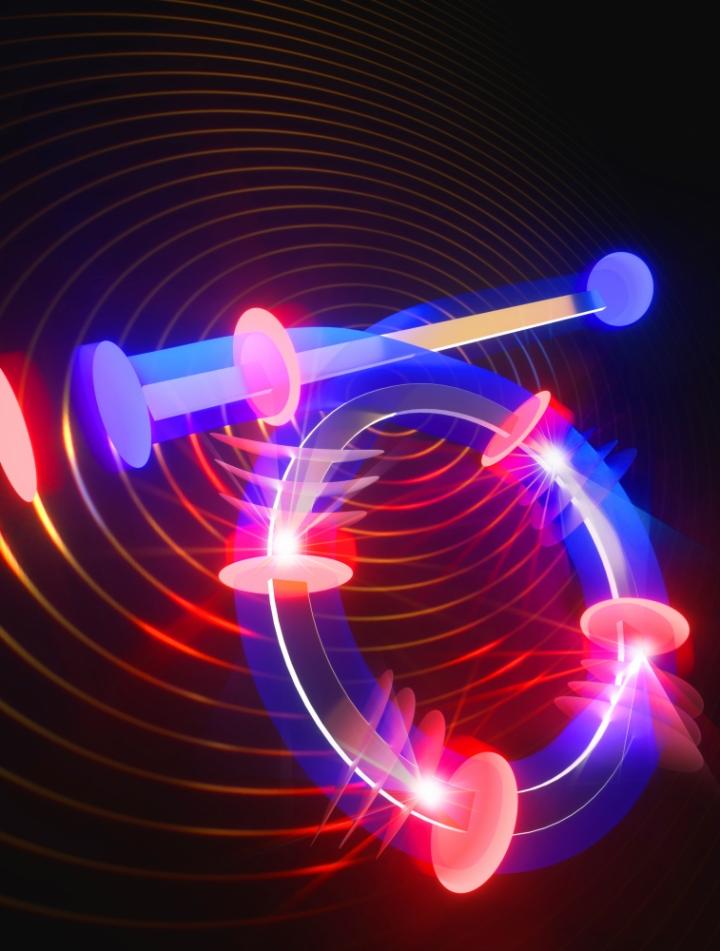
Collaborators Develop an Ultra Quiet Laser, with Chip-scale Applications
Researchers at the University of California, Santa Barbara and their collaborators at Honeywell, Yale, and Northern Arizona University have developed a chip-scale laser capable of emitting light with a fundamental linewidth of less than 1 hertz (Hz) — a frequency that is quiet enough to allow scientific applications requiring highly coherent lasers to be moved to the chip scale.
The project was funded under the Defense Advanced Research Project Agency’s (DARPA) OwlG initiative. DARPA was interested in creating a chip-scale laser optical gyroscope for precision positioning and navigation.
The laser optical gyroscope has a length-scale sensitivity on par with that of the gravitational wave detector, one of the most precise measuring instruments ever made. But current systems that achieve this sensitivity incorporate bulky coils of optical fiber. The goal of the OwlG project was to develop a narrow-linewidth laser on a chip to replace the bulky fiber as the rotation-sensing element and allow further integration with other components of the optical gyroscope.
According to professor Dan Blumenthal, there are two possible ways to build such a laser. One is to tether a laser to an optical reference that must be environmentally isolated and contained in a vacuum, as is done with atomic clocks. The reference cavity and an electronic feedback loop together act as an anchor to quiet the laser. Such systems, however, are large, costly, power-consuming, and sensitive to environment disturbances.

Artist’s interpretation of the optical dynamics inside the laser ring cavity of the new Brillouin laser. Courtesy of Brian Long.
The other approach is to make an external-cavity laser whose cavity satisfies the fundamental physical requirements for a narrow-linewidth laser, including the ability to hold billions of photons for a long time and support very high internal optical power levels. Traditionally, such cavities are made large so they can hold enough photons. Although they have been used to achieve high performance, integrating them on-chip with linewidths approaching those of lasers has been a challenge.
To overcome these limitations, the research team leveraged a phenomenon known as stimulated Brillouin scattering to build the lasers.
“Our approach uses this process of light-matter interaction in which the light actually produces sound, or acoustic, waves inside a material,” Blumenthal said. “Brillouin lasers are well known for producing extremely quiet light. They do so by utilizing photons from a noisy pump laser to produce acoustic waves, which, in turn, act as cushions to produce new quiet, low-linewidth output light. The Brillouin process is highly effective, reducing the linewidth of an input pump laser by a factor of up to a million.”
However, the optical setups traditionally used to make Brillouin lasers are sensitive to environmental conditions and difficult to fabricate using chip-foundry methods. “The key to making our sub-Hz Brillouin laser on a photonic integrated chip was to use a technology developed at UC Santa Barbara — photonic integrated circuits built with waveguides that are extremely low loss, on par with the optical fiber,” Blumenthal said. “These low-loss waveguides, formed into a Brillouin laser ring cavity on the chip, have all the right ingredients for success: They can store an extremely large number of photons on the chip, handle extremely high levels of optical power inside the optical cavity, and guide photons along the waveguide much as a rail guides a monorail train.”
A combination of low-loss optical waveguides and rapidly decaying acoustic waves removes the need to guide the acoustic waves. This innovation is key to the success of its approach, said the team. Since its completion, this research has led to multiple new funded projects both in Blumenthal’s group and in those of his collaborators.
Moving the performance of high-end lasers onto photonic microchips could reduce the cost and size of this laser technology, making it available to a wide range of applications including spectroscopy, navigation, quantum computation, and optical communications. Achieving such performance at the chip scale would also help to address the challenge posed by the internet’s exploding data-capacity requirements and the resulting increase in worldwide energy consumption of data centers and their fiber optic interconnects.
The research was published in Nature Photonics (https://doi.org/10.1038/s41566-018-0313-2).
/Buyers_Guide/Honeywell_Safety_Products_USA_Inc/c17179
/Buyers_Guide/Honeywell_Aerospace/c24731